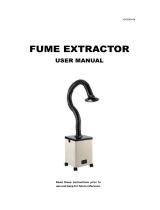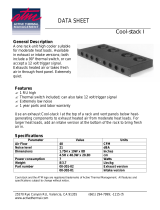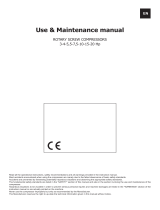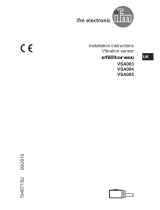Page is loading ...

Operation Manual
ABB Turbocharging
ABB Turbo Systems Ltd
CH 5401 Baden
Type TPL69-A10 HT842690
n
Mmax
426 t
Mmax
650
n
Bmax
405 t
Bmax
620
1/s °C
01780 36 50 50
Year 2017
made in Switzerland
Application according to
the Operation Manual
kg
HZTL2481 English
TPL69-A10
Original Operation Manual

Operating condition and replacement intervals
The operational limits for the turbocharger nBmax, tBmax, nMmax, tMmax, inspection- and replacement intervals for the compon-
ents concerned on the rating plate are valid for the operational mode and compressor inlet condition, which has been agreed upon
between the engine builder and ABB.
Note: Replacement intervals of components depends on the load profi le, turbine inlet temperature, suction air temperature and
turbocharger speed. In case the operation conditions differs signifi cantly from what is considered to be normal for the cur-
rent application, it is recommended to contact ABB for a re-calculation of replacement intervals. Frequent load alterations,
high temperatures and high speed lower the life of components.
Unless otherwise agreed, the application limits nMmax, tMmax are valid for the test operation for a limited time.

Operation Manual / TPL69-A10 / -A30 ... TPL77-A10 / -A30
Table of contents
Page 1
© Copyright 2016 ABB. All rights reserved.
December 2016 HZTL2481_EN Revision B
Table of contents
1
Preliminary remarks
1.1
Purpose of this manual
1.2
Layout and function
1.3
Intended use of the turbocharger
1.4
Storage of new turbochargers and spare parts
1.5
Essential information
1.6
Symbols and definitions
1.7
Turbocharger rating plate
1.8
Contact information
2
Safety
2.1
Introduction
2.2
CE conformity
2.3
Definition of mandatory signs
2.4
Definition of Safety instructions
2.5
Warning plates on the turbocharger
2.6
Safe operation and maintenance
2.7
Hazards during operation and maintenance
2.8
Periodic checking of the pressure vessel
2.9
Lifting loads
3
Start-up
3.1
Oil supply
3.2
Inspection work
3.3
Commissioning after taking out of operation
4
Operation
4.1
Noise emissions
4.2
Servicing work
4.3
Replacement intervals for turbocharger components
4.4
Speed measurement
4.5
Underpressure measurement on filter silencer
4.6
Stopping the engine

Operation Manual / TPL69-A10 / -A30 ... TPL77-A10 / -A30
Table of contents
Page 2
© Copyright 2016 ABB. All rights reserved.
December 2016 HZTL2481_EN Revision B
5
Maintenance
5.1
Foreword to Maintenance
5.2
Cleaning the filter silencer
5.3
Cleaning the compressor during operation
5.4
Cleaning turbine blades and nozzle ring in operation
5.5
Cleaning components mechanically
6
Troubleshooting
6.1
Malfunctions when starting
6.2
Surging of the turbocharger
6.3
Malfunctions during operation
6.4
Malfunctions when stopping
6.5
Speed measurement system
7
Removal and installation
7.1
Turbocharger weights
7.2
Removing the turbocharger
7.3
Installing the turbocharger
8
Disassembly and assembly
8.1
Introduction
8.2
Module weights
8.3
Removing and fitting filter silencer or air suction branch
8.4
Axial clearance
8.5
Removing cartridge group
8.6
Dismantling and installing the turbine diffuser and nozzle ring
8.7
Installing cartridge group
8.8
Dismantling and fitting nozzle ring at turbine end
8.9
Table of tightening torques
9
Taking out of operation at short notice
9.1
Possibilities for emergency repair
9.2
Locking the rotor
9.3
Fit cover plate
9.4
Blocking the inlets and outlets
9.5
Bypass the turbocharger
10
Mothballing the turbocharger

Operation Manual / TPL69-A10 / -A30 ... TPL77-A10 / -A30
Table of contents
Page 3
© Copyright 2016 ABB. All rights reserved.
December 2016 HZTL2481_EN Revision B
10.1
Taking the engine out of operation for up to 12 months
10.2
Taking the engine out of operation for more than 12 months
11
Disposing of turbocharger components
12
Spare parts
12.1
Ordering spare parts
12.2
View of turbocharger with part numbers
12.3
View of turbine cleaning system with part numbers (optional)


Operation Manual / TPL69-A10 / -A30 ... TPL77-A10 / -A30
Preliminary remarks
1
Purpose of this manual
1.1
Page 5
© Copyright 2016 ABB. All rights reserved.
December 2016 HZTL2481_EN Revision B
Preliminary remarks
Purpose of this manual
1.1
This Operation Manual belongs to the turbocharger with the identical seri-
al number (01), see the cover sheet of the Operation Manual and the tur-
bocharger rating plate.
Operation Manual
This Operation Manual enables you to familiarize yourself with the turbo-
charger supplied by ABB Turbo Systems and to use it as intended.
It provides important information in order that the turbocharger can be op-
erated safely, correctly and efficiently.
This Operation Manual complements and expands existing national regu-
lations concerning work safety and accident prevention.
Target group
This Operation Manual is intended for engineers and qualified mechanics
who are responsible for operating the engine and the turbocharger in-
stalled on it.
Availability of operation manual
An operation manual must be available at all times at the place where the
turbocharger is used.
Everyone who operates or works on the turbocharger must have first read
and understood the operation manual.
1
1.1

Operation Manual / TPL69-A10 / -A30 ... TPL77-A10 / -A30
Preliminary remarks
1
Layout and function
1.2
Page 6
© Copyright 2016 ABB. All rights reserved.
December 2016 HZTL2481_EN Revision B
Layout and function
1.2
01
Filter silencer 08
Nozzle ring
02
Radial plain bearing 09
Turbine wheel
03
Thrust bearing 10
Bearing casing
04
Bearing bush 11
Diffuser
05
Radial plain bearing 12
Compressor wheel
06
Gas outlet casing 13
Compressor casing
07
Gas inlet casing
1.2

Operation Manual / TPL69-A10 / -A30 ... TPL77-A10 / -A30
Preliminary remarks
1
Layout and function
1.2
Page 7
© Copyright 2016 ABB. All rights reserved.
December 2016 HZTL2481_EN Revision B
Mode of operation
The turbocharger is a turbomachine and consists of the following main
components:
Turbine
Compressor
These are both mounted on a common shaft.
The exhaust gases from the diesel engine flow through the gas inlet cas-
ing (07) and nozzle ring (08) to the turbine wheel.
The turbine wheel (09) uses the energy contained in the exhaust gas to
drive the compressor wheel (12). The compressor then draws in fresh air,
compresses it and then forces it into the cylinders.
The exhaust gases escape to free air through an exhaust gas pipe which
is connected to the gas outlet casing (06).
The air which is necessary for operation of the diesel engine and is com-
pressed in the turbocharger is drawn through the suction branch or the fil-
ter silencer (01) into the compressor wheel (12). This air then passes
through the diffuser (11) and leaves the turbocharger through the com-
pressor casing (13).
The rotor runs in two radial plain bearings (02/05). One plain bearing is in
the bearing bush (04), and the second one is in the axial thrust bearing
(03) at the compressor end.
The plain bearings are connected to a central lubricating oil duct which is
fed with oil from the engine's lubricating oil circuit. The oil outlet is always
at the lowest point of the bearing casing (10).
Turbocharger version with compressor wheel cooling system
Depending on its range of use, the turbocharger is provid-
ed with a compressor wheel cooling system. Compressor
wheel cooling means that, after the charge air cooler at the
engine end, cooled compressor air is delivered to the tur-
bocharger to cool the compressor wheel.
Under the appropriate operating conditions, it is essential
that the compressor wheel is cooled in order to guarantee
its reliability and the replacement intervals. In the case of
the turbocharger version with compressor wheel cooling,
the cooling air is supplied through the side connection (15)
in the bearing casing.

Operation Manual / TPL69-A10 / -A30 ... TPL77-A10 / -A30
Preliminary remarks
1
Intended use of the turbocharger
1.3
Page 8
© Copyright 2016 ABB. All rights reserved.
December 2016 HZTL2481_EN Revision B
Intended use of the turbocharger
1.3
NOTICE
This turbocharger supplied by ABB Turbo Systems has been developed
for use on diesel engines to generate the volume of air and the charg-
ing pressure required to operate the engine.
The engine builder has provided ABB Turbo Systems with information
regarding the intended use of the engine, from which the operating lim-
its specific to the turbocharger shown on the rating plate (such as oper-
ating speeds, temperatures, exchange intervals / replacement intervals)
have been derived.
If it is
used
in conjunction
with a gas engine
, the engine must
not
be in-
stalled in a potentially
explosive environment
, and precautionary
measures must be taken to ensure that the machine room as a whole is
classified as
not potentially explosive
.
Any other use will be regarded as a special application which must first
be discussed with ABB Turbo Systems. The manufacturer accepts no
liability for other applications. If it is used otherwise, ABB Turbo Sys-
tems reserves the right to reject all warranty claims.
This turbocharger was built according to state-of-the-art technology and is
operationally safe according to recognised safety regulations.
WARNING
Improper operation and maintenance of the turbocharger can result in
danger to life and limb of the user or third parties. In addition, improper
use may cause damage to the machine.
The machine may be operated only by trained personnel.
Use of the turbocharger as intended also includes observance of the in-
stallation / fitting, disassembly / removal, operating, maintenance / servic-
ing and repair conditions specified by the manufacturer. Disposal regula-
tions set down by local authorities must be observed.
The turbocharger may be installed only when in technically perfect condi-
tion while observing the instructions given in the engine builder's manual.
It may be used only for the intended purpose and operated in compliance
with the operation manual.
Malfunctions which could affect safety must be eliminated immediately.
The manufacturer accepts no liability for any damage resulting from unau-
thorised alterations to the turbocharger.
1.3
State of the art
Perfect condition

Operation Manual / TPL69-A10 / -A30 ... TPL77-A10 / -A30
Preliminary remarks
1
Storage of new turbochargers and
spare parts
1.4
Page 9
© Copyright 2016 ABB. All rights reserved.
December 2016 HZTL2481_EN Revision B
Storage of new turbochargers and spare
parts
1.4
Storage of new turbochargers and spare parts up to 6 months
New turbochargers and spare parts from ABB Turbo Systems can be
stored in sealed packaging without additional mothballing measures for up to
6 months from the date of delivery (marked by the VCI label on the package).
V
olatile
C
orrosion
I
nhibitor (VCI)
Only dry rooms in which the relative humidity is between 40…70 % and
no condensation can form are suitable for storage.
Storage of new turbochargers and spare parts for more than 6 months (VCI)
WARNING
Protection of health when handling VCIs
VCI products are not hazardous in the sense of the Hazardous Sub-
stances Ordinance. Nevertheless, the following points are to be ob-
served when handling VCIs:
Ensure good room ventilation.
Do not eat, drink or keep food at the workplace while working with
VCIs.
Wear safety gloves.
Clean hands and face after working with VCIs.
For further information refer to www.branopac.com.
Wear safety gloves to protect against chemical hazards.
The following mothballing measures are required every 6 months:
Open the package.
Remove the VCI corrosion protection emitter from the package and
replace it with a new, identical VCI corrosion protection emitter. New
VCI corrosion protection emitters can be obtained at
www.branopac.com.
Dispose of the old VCI corrosion protection emitter in an environmen-
tally compatible manner, professionally and in accordance with local
regulations.
Seal the package. The better the external seal is designed, the more
permanent the protection.
1.4

Operation Manual / TPL69-A10 / -A30 ... TPL77-A10 / -A30
Preliminary remarks
1
Storage of new turbochargers and
spare parts
1.4
Page 10
© Copyright 2016 ABB. All rights reserved.
December 2016 HZTL2481_EN Revision B
Long-term storage of replacement turbochargers or spare parts
Per order, turbochargers or cartridge groups will be prepared by ABB Tur-
bo Systems for prolonged storage. The package is equipped with a hyg-
rometer (see illustration).
The following measures are required every 6 months:
Check the hygrometer (02) in the sight-glass. There is an opening (01)
in the wooden crate which allows this check to be carried out. When
the display field has changed colour at the 70% level, the maximum
permissible humidity has been exceeded. In this case the turbocharger
or rotor must be inspected by an ABB Turbocharging Service Station
and repacked.
Inspect the package for damage. If the package is damaged, the tur-
bocharger or cartridge group must be inspected by an ABB Turbo-
charging Service Station and repacked.
After every 3 years the following work steps must be performed by an
ABB Turbocharging Service Station:
Inspect the components
Exchange the desiccant agent
Repackage the components.
NOTICE
Replacement components ready for operation
If the 70% display field of the hygrometer (02) has not changed colour
and the package is undamaged, the replacement turbocharger or re-
placement cartridge group can be placed into operation without any pri-
or testing by an ABB Turbocharging Service Station.
Unpacking replacement turbochargers or spare parts
The corrosion protection effect ends after the material is unpacked from
the VCI package.
To avoid the formation of condensation, the surroundings and the content
of the package must have the same temperature during unpacking.

Operation Manual / TPL69-A10 / -A30 ... TPL77-A10 / -A30
Preliminary remarks
1
Essential information
1.5
Page 11
© Copyright 2016 ABB. All rights reserved.
December 2016 HZTL2481_EN Revision B
Essential information
1.5
Organisational measures
In addition to this manual, the general, statutory regulations applicable in
the respective country for the prevention of accidents and the protection of
the environment must be observed.
This also applies to the provision and wearing of personnel protection
equipment.
NOTICE
The safety and risk consciousness of the personnel working on and
with the turbocharger must be checked regularly with reference to this
manual.
The turbocharger must be shut down immediately by stopping the en-
gine in the event of alterations affecting safety or of corresponding op-
erating behaviour. The fault must be reported to the person or depart-
ment responsible.
NOTICE
Additions and alterations to, and conversions of the turbocharger that
could compromise safety require the prior approval of ABB Turbo Sys-
tems.
1.5

Operation Manual / TPL69-A10 / -A30 ... TPL77-A10 / -A30
Preliminary remarks
1
Essential information
1.5
Page 12
© Copyright 2016 ABB. All rights reserved.
December 2016 HZTL2481_EN Revision B
Original parts and safety
Original parts and accessories are specially designed for the turbocharger
supplied by ABB Turbo Systems.
WARNING
Use original parts
Operation of the turbocharger with non-original parts can impair the
safety of the turbocharger and can cause serious damage to property
and injury to personnel.
Only use original parts from ABB Turbo Systems.
ABB Turbo Systems accepts no liability for any damage resulting from the
use of non-original parts and corresponding accessories.
Competence of personnel
The turbocharger must only be operated and serviced by trained and au-
thorised personnel. Basic mechanical training is a prerequisite.
Design variants
This document is valid for different design variants of turbochargers.
There may be sections and descriptions of components that are not rele-
vant for a specific turbocharger variant.
ABB Turbocharging Service Stations will be happy to provide information
on questions regarding a design variant (see Contact information at
www.abb.com/turbocharging).
Accuracy of illustrations
The illustrations in this document are general in nature and intended for
ease of understanding. Differences in detail are therefore possible.
Registered trademarks
Registered trademarks of external companies are used in this document.
The trademarks are marked with ®.

Operation Manual / TPL69-A10 / -A30 ... TPL77-A10 / -A30
Preliminary remarks
1
Symbols and definitions
1.6
Page 13
© Copyright 2016 ABB. All rights reserved.
December 2016 HZTL2481_EN Revision B
Symbols and definitions
1.6
The following symbols are used in the documents:
Prerequisite
Step of a procedure
List, first level
- List, second level
[➙ ] Refers to a page number
Definition of notes
NOTICE
Note
A note provides suggestions which facilitate the work on the product.
Definition of mandatory signs
Mandatory signs show the protective equipment to be worn for a task. The
mandatory signs are described in chapter Safety and must be complied
with.
Definition of caution / warning
The caution and warning signs are described in the chapter Safety.
ABB Turbo Systems
In this document, ABB Turbo Systems Ltd is abbreviated to ABB Turbo
Systems.
Official ABB Turbo Systems Service Stations
In this document, official service stations are referred to as ABB Turbo-
charging Service Stations. They are inspected and certified regularly by
ABB Turbo Systems. See also chapter Contact information [➙ 16].
1.6

Operation Manual / TPL69-A10 / -A30 ... TPL77-A10 / -A30
Preliminary remarks
1
Turbocharger rating plate
1.7
Page 14
© Copyright 2016 ABB. All rights reserved.
December 2016 HZTL2481_EN Revision B
Turbocharger rating plate
1.7
01
Turbocharger operating limits at engine overload (110 %).
Only when operating in the test rig unless otherwise agreed with the en-
ginebuilder.
02
Turbocharger operating limits during operation
03
Replacement interval for plain bearings in 1000 h
04
Replacement interval for compressor in 1000 h
05
Replacement interval for turbine in 1000 h
06
Customer part number
07
Designation of the special design
08
Turbocharger weight in kg
09
Turbocharger type
10
Serial number
11
Year of construction of turbocharger
12
Manufacturing plant
1.7
Operating limits
Recommended replace-
ment intervals for turbo-
charger components
Further information

Operation Manual / TPL69-A10 / -A30 ... TPL77-A10 / -A30
Preliminary remarks
1
Turbocharger rating plate
1.
7 Page 15
© Copyright 2016 ABB. All rights reserved.
December 2016 HZTL2481_EN Revision B
Explanation of the rating plate
The recommended replacement intervals and the corresponding opera-
tional limits are jointly defined with the engine manufacturer. This informa-
tion is specific to the system.
Operation above the indicated values n
Bmax
, t
Bmax
can considerably shorten the
recommended replacement intervals. In such cases, we recommend that you
contact the nearest official ABB Turbocharging service station.
n
Mmax
and t
Mmax
normally apply only when running at overload (110%) during tri-
als on the engine test bed. These limits can also be permitted during operation
for special applications. Operation above n
Mmax
and t
Mmax
is not permitted.
Non-observance of the recommended replacement intervals can increase the
risk of unpredictable component failures.
Positions of the rating plates
A rating plate is attached to the turbocharger foot, one on the left and one
on the right. In the case of turbochargers with insulation supplied by ABB
Turbo Systems, at least one additional rating plate is attached to the insu-
lation of the gas outlet casing.
1.7.1
1.7.2

Operation Manual / TPL69-A10 / -A30 ... TPL77-A10 / -A30
Preliminary remarks
1
Contact information
1.8
Page 16
© Copyright 2016 ABB. All rights reserved.
December 2016 HZTL2481_EN Revision B
Contact information
1.8
Contact information
Contact information for the official service stations of ABB Turbo Systems
is available online.
Scan the QR code to access our website.
ABB Turbo Systems Ltd
Bruggerstrasse 71a
CH-5401 Baden
Switzerland
www.abb.com/turbocharging
1.8

Operation Manual / TPL69-A10 / -A30 ... TPL77-A10 / -A30
Safety
2
Introduction
2.1
Page 17
© Copyright 2016 ABB. All rights reserved.
December 2016 HZTL2481_EN Revision B
Safety
Introduction
2.1
Turbochargers manufactured by ABB Turbo Systems are state of the art
and comply with the pertinent safety and health-protection requirements
that applied when the turbocharger was manufactured. Consequently, the
turbocharger is safe to operate. Nevertheless, during turbocharger opera-
tion and when working on the turbocharger, residual risks can exist which:
originate from the turbocharger itself and its accessories
originate from the operating and auxiliary materials used
are the consequence of insufficient observance of the safety instruc-
tions
are the consequence of unsatisfactory and improper execution of
maintenance and inspection work
The operator is responsible for access to the turbocharger as well as the
organisational measures which regulate the safe handling of the turbo-
charger by his personnel.
All instructions in this chapter must be observed to ensure safe and trou-
ble-free turbocharger operation and during work on the turbocharger.
In the same vein, all other specially marked safety instructions in every
chapter of this manual must be observed (see the section entitled Defini-
tion of safety instructions).
CE conformity
2.2
Information
ABB turbochargers fulfil Directive 2006/42/EC on machinery and are con-
sidered partly completed machinery in the sense of Article 2 g.
2
2.1
2.2

Operation Manual / TPL69-A10 / -A30 ... TPL77-A10 / -A30
Safety
2
Definition of mandatory signs
2.3
Page 18
© Copyright 2016 ABB. All rights reserved.
December 2016 HZTL2481_EN Revision B
Definition of mandatory signs
2.3
To be worn at all times
Protective clothing
Safety footwear
against
mechanical hazards
To be worn according to the specific work
Safety glasses
Safety goggles
Safety gloves
against
- mechanical hazards
- chemical hazards
- heat hazards
Respiratory mask
against
- dust
- gases
Safety helmet
Ear protection
Definition of Safety instructions
2.4
The following symbols and terms used in this manual concern safety or
refer to possible hazards:
WARNING
Definition of warning
Serious personal injuries and even accidents with fatal consequences
may occur if work and operating instructions marked with this symbol and
the word
WARNING
are either not followed or not followed precisely.
Warning signs must be observed at all times.
CAUTION
Definition of caution
Serious machine or property damage may occur if work and operating
instructions marked with this symbol and the word
CAUTION
are either
not followed or not followed precisely.
Caution signs must be observed at all times
.
2.3
2.4
/



